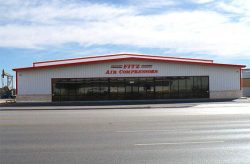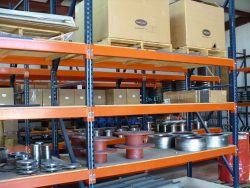The Different Air Compressor Types
Air compressors are powerful devices that convert power into kinetic energy in the form of compressed air. This energy can be harnessed to operate various types of pneumatic equipment, power tools and other devices across different industries.
Air compressors are versatile pieces of equipment. Their versatility stems from the fact that they come in varying specifications and sizes to suit a wide range of applications, from construction to manufacturing to engineering.
Through these varying specifications, similarities and differences exist, giving rise to several classifications. Below, we delve into these classifications by defining the different air compressor types commonly used today.
Classifications of Air Compressors
There are many different ways to classify air compressors. They can be classified according to the amount of pressure they can deliver, pressure ratio, capacity, overall design and the principle in which they operate.
More information about these classifications can be found below.
Pressure Range
Air compressors can be classified according to the amount of pressure they can deliver through compressed air. This is also known as their pressure rating, which is defined as the amount of force it can deliver per area. Its most common unit is pounds per square inch (psi).
- Low-Pressure Air Compressors – below 145 psi (< 10 bar)
- Medium-Pressure Air Compressors – between 145 – 1,160 psi (10 – 80 bar)
- High-Pressure Air Compressors – between 1,160 – 14,500 psi (80 – 1,000 bar)
- Very High-Pressure Air Compressors – above 14,500 psi (> 1,000 bar)
Most equipment used in workshops and manufacturing settings are designed to operate at around 90 – 100 psi (6 – 7 bar) and will only require low-pressure compressors. On the other hand, compressors with pressure ratings above 10 bar are used for heavier loads, such as in scuba diving devices, industrial high-pressure devices, and the aerospace industry.
Volume Flow Rate or Capacity
The volume flow rate also refers to the compressor’s capacity and is defined as the amount of air the compressor can pump out at a given pressure. It is also known as the CFM rating because it is commonly expressed in cubic feet of air per minute (CFM).
- Low-Capacity Air Compressors – less than 0.15 m3/s (< 318 ft3/min)
- Medium-Capacity Air Compressors – between 0.15 – 5 m3/s (10,600 ft3/min)
- High-Capacity Air Compressors – greater than 5 m3/s (> 10,600 ft3/min)
Design Principle
Air compressors force atmospheric air under pressure to store potential energy inside a tank, which can then be converted to kinetic energy once the pressure is released. This can be achieved using two basic principles: positive displacement and dynamic compression. Air compressors can also be classified based on the principle they use to store compressed air.
- Positive Displacement: Air pressure increases by reducing the air volume inside the tank. Air is drawn into one or multiple compression chambers, whose volume gradually decreases until the designed pressure ratio is reached.
- Dynamic: A rotating motor imparts kinetic energy to air to increase pressure. This is done by drawing air between a rapidly rotating compression impeller’s blades and accelerating to a high velocity. The air is then discharged through a diffuser, transforming the kinetic energy into static pressure.
Different air compressor types operate under these design principles and will be discussed in more detail in the following section.
Positive Displacement Air Compressors
The different types of positive displacement air compressors include the following:
Rotary Screw Compressors
Rotary screw compressors are one of the most commonly used air compressors in most workshops since the 1980s and can be found in sizes ranging from about 5 to 900 hp. They typically comprise two main parts: male and female rotors that rotate in opposite directions. As both rotors rotate, the air is drawn and compressed as the space between the rotors and their housing decreases.
The most common type of rotary screw compressor is the helical twin. This type uses two mated rotors that mesh together to trap air and reduce its volume along the rotors to increase pressure.
Reciprocating Compressors
Reciprocating compressors are the oldest and most common type of air compressors for industrial use. Also known as piston compressors, reciprocating compressors have a moving piston that creates forward and backward movement through a connecting rod and a rotating crankshaft, compressing air drawn into a cylinder.
Reciprocating compressors can be further classified based on the action of the piston and how many sides are utilized. Single-acting compressors only use one side for compression, while double-acting compressors use both.
An electric motor is used to drive the piston through a crankshaft in order to compress air. These are typically used for general-purpose equipment and can be obtained commercially in sizes ranging from about 1 hp to 30 hp.
Vane Compressors
Rotary vane compressors use elliptical slotted rotors inside a cylinder to compress air. Each slot contains a vane that moves in and out while sweeping the cylinder, simultaneously sucking in air on one side and ejecting it on the other. When the compressor is rotating, these vanes are forced outwards by centrifugal force. This continuous action compresses air until the rated pressure is achieved.
Vane compressors are typically used for smaller applications that only require a little space or if floor space is limited. While these are great for general applications such as agriculture, dry cleaning, or woodworking, they are not as efficient as reciprocating and rotary screw compressors.
Dynamic-Type Air Compressors
The following are the two most common types of dynamic air compressors:
Centrifugal Compressors
In centrifugal compressors, the air is drawn in from the outside instead of a closed serve, which is then forced inside its chamber through the action of a rotor known as the impeller. This can be done either as a single stage or multiple stages to increase the air pressure and deliver more power.
Multi-stage compressors are known for delivering high amounts of power and are ideal for heavier equipment. They are also well-suited for longer jobs because they can be operated continuously.
Centrifugal compressors are also known for being more affordable than other compressor types with similar horsepower. However, they rely on fast-moving parts for their function, which makes them prone to such issues as choking or stalling.
Axial Compressors
Like centrifugal compressors, axial compressors also take in air from the outside rather than from a reserve chamber. However, instead of using an impeller, they use fan blades in a row located inside a shaft. Air increases velocity as it passes through each row, increasing its pressure.
Axial compressors are relatively smaller and lighter than centrifugal compressors. However, they typically have higher operation speeds, which allows them to supply air at a constant flow rate at higher volumes. This does come at a cost, as this constant flow rate leads to less pressure.
Axial compressors are commonly used in applications that require pumping because of their energy efficiency and consistency. As such, they are used as key components in jet engines, pumps and construction generators.
Frequently Asked Questions
What is the difference between a single-stage and two-stage air compressor, and which one is better suited for my needs?
The main difference between a single-stage compressor and a two-stage compressor is the number of stages. As the name indicates, a single-stage compressor involves only one stage of compression, after which air is channeled to a storage chamber or outlet for the intended application. In contrast, a two-stage compressor involves compressing air in two stages, which increases the amount of power it can deliver.
To know which is better suited for your needs, you must look at its intended application. Single-stage compressors deliver less power than two-stage compressors, making them ideal for smaller-scale applications.
What is the difference between a reciprocating and rotary screw air compressor?
Both reciprocating and rotary screw air compressors compress air through positive displacement. However, they are different because rotary compressors use two screws that turn in opposing directions to compress air, while reciprocating compressors use pistons that move forward and backward to achieve the same effect.
How do I determine the correct size of air compressor I need for my application?
Generally, smaller air compressors have less pressure ratings, delivering less power than their larger counterparts. However, instead of assessing your needs based on physical size, you can better determine the right compressor from its capacity.
Take a look at your intended application’s CFM requirements. If you intend to use a single compressor for a wide range of tools, look for the tool with the highest CFM requirement.
If you’re using tools that require continuous use, determine whether their CFM rating is for 100% duty cycle since these may be rated as if you’re using them at 50 – 60%. If this is the case, you will need a higher CFM rating.
Lastly, if you intend to use all your tools simultaneously, combine their CFM ratings to find a compressor that can fulfill this requirement.
Can I use an air compressor for pneumatic tools other than just powering them, such as sanding or painting?
While many people view air compressors as a tool, they are actually devices that can be used to power tools intended for a wide range of applications. Through the kinetic energy released from compressed air, they can be used to power various pneumatic tools, such as:
- Drills
- Orbital sanders
- Air hammers
- Socket wrenches
- Grease guns
- Paint guns
- Speed saws
- Hydraulic riveters
- Needle scalers
Your One-Stop Resource For Industrial Air Compressors
Fitz Equipment has been a leading provider of Gardner Denver Industrial Air Compressors and other notable brands, including Kaeser, Joy, Champion, National, Allison, and Twin Disc. Having been in service for over 50 years, we pull from our extensive experience and expertise in diverse industrial applications to provide an impressive array of product offerings to help you meet the performance standards and requirements in your industry.
To learn more about our industrial air compressors or for immediate assistance, call us at 888 220 3489.




